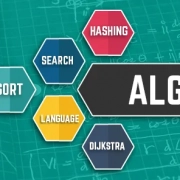Bubble Sort Algorithm: A Deep Dive into Sorting Simplicity
In the world of computer science and programming, sorting algorithms play a pivotal role in organizing data efficiently. One of the most elementary yet enlightening algorithms in this realm is the Bubble Sort algorithm. Despite its simple and somewhat naive approach, Bubble Sort provides a foundational understanding of sorting techniques and serves as a stepping stone to more advanced algorithms. In this article, we’ll delve into the mechanics, complexities, applications, and even its historical significance.
The Dance of Bubbles: How Bubble Sort Works
Imagine a row of bubbles rising through a liquid. As the bubbles ascend, smaller bubbles naturally move to the top, and larger bubbles sink towards the bottom. This imagery bears a striking resemblance to how the Bubble Sort algorithm functions in sorting elements within an array.
Bubble Sort is a comparison-based algorithm that repeatedly steps through the list, compares adjacent elements, and swaps them if they are in the wrong order. The process continues until no more swaps are needed, signifying that the array is sorted.
Here’s a simplified step-by-step breakdown of the Bubble Sort process:
- Start with the first element of the array.
- Compare it with the next element.
- If the current element is greater than the next element, swap them.
- Move to the next pair of elements and repeat steps 2-3.
- Continue this process until the largest element “bubbles up” to the end of the array.
- Now, start again from the beginning of the array and repeat the process, excluding the last (already sorted) element.
- Repeat these steps until the entire array is sorted.
While conceptually straightforward, Bubble Sort’s efficiency and performance are far from ideal, especially for large datasets. This leads us to the exploration of time complexity.
The Complexity Conundrum: Time and Space Complexity
Bubble Sort’s charm lies in its simplicity, but its performance leaves much to be desired when dealing with sizable datasets. The algorithm’s time complexity is O(n^2), where ‘n’ represents the number of elements in the array. This quadratic time complexity arises from the fact that for each element, the algorithm potentially makes ‘n’ comparisons during the worst-case scenario.
The best-case scenario occurs when the input array is already sorted. Even then, Bubble Sort requires a full pass through the array to confirm the sorted order, resulting in a time complexity of O(n).
In terms of space complexity, Bubble Sort is quite efficient, requiring only a constant amount of additional memory for temporary variable storage during swaps. Thus, its space complexity is O(1).
Historical Footprints: Bubble Sort’s Legacy
The Bubble Sort algorithm has a history that dates back to the early days of computer science. Its origins can be traced to the work of cocktail shaker sort, a mechanical sorting device dating back to 1956. This device inspired computer scientists and programmers to develop an analogous sorting algorithm for computers.
The term “Bubble Sort” first appeared in a 1956 paper titled “An Investigation of Sorting Algorithms” by R.W. Doran. Despite its initial simplicity, the algorithm underwent numerous refinements and variations over the years.
Real-world Relevance and Educational Value
While Bubble Sort may not be the most efficient sorting algorithm for large datasets, it retains its relevance as a valuable teaching tool. Its uncomplicated implementation makes it an ideal introductory algorithm for new programmers to grasp the concept of sorting. Understanding Bubble Sort’s mechanics provides a foundation for comprehending more advanced sorting algorithms, such as Quick Sort and Merge Sort.
Furthermore, Bubble Sort’s straightforward nature makes it suitable for educational purposes, algorithm analysis, and even interviews for aspiring programmers. Interviewers might present Bubble Sort challenges to candidates as a means of assessing their logical thinking and understanding of basic algorithms.
Conclusion
In the vast landscape of sorting algorithms, Bubble Sort stands as a beacon of simplicity and foundational knowledge. Its mechanics, though basic, offer profound insights into the world of sorting and algorithmic thinking. While its performance might be lacking for large datasets, the value of Bubble Sort as a pedagogical tool and historical artifact cannot be overstated. As new programmers learn to navigate the intricacies of sorting, they will undoubtedly encounter the bubbly wisdom that has guided countless others on their coding journeys.






